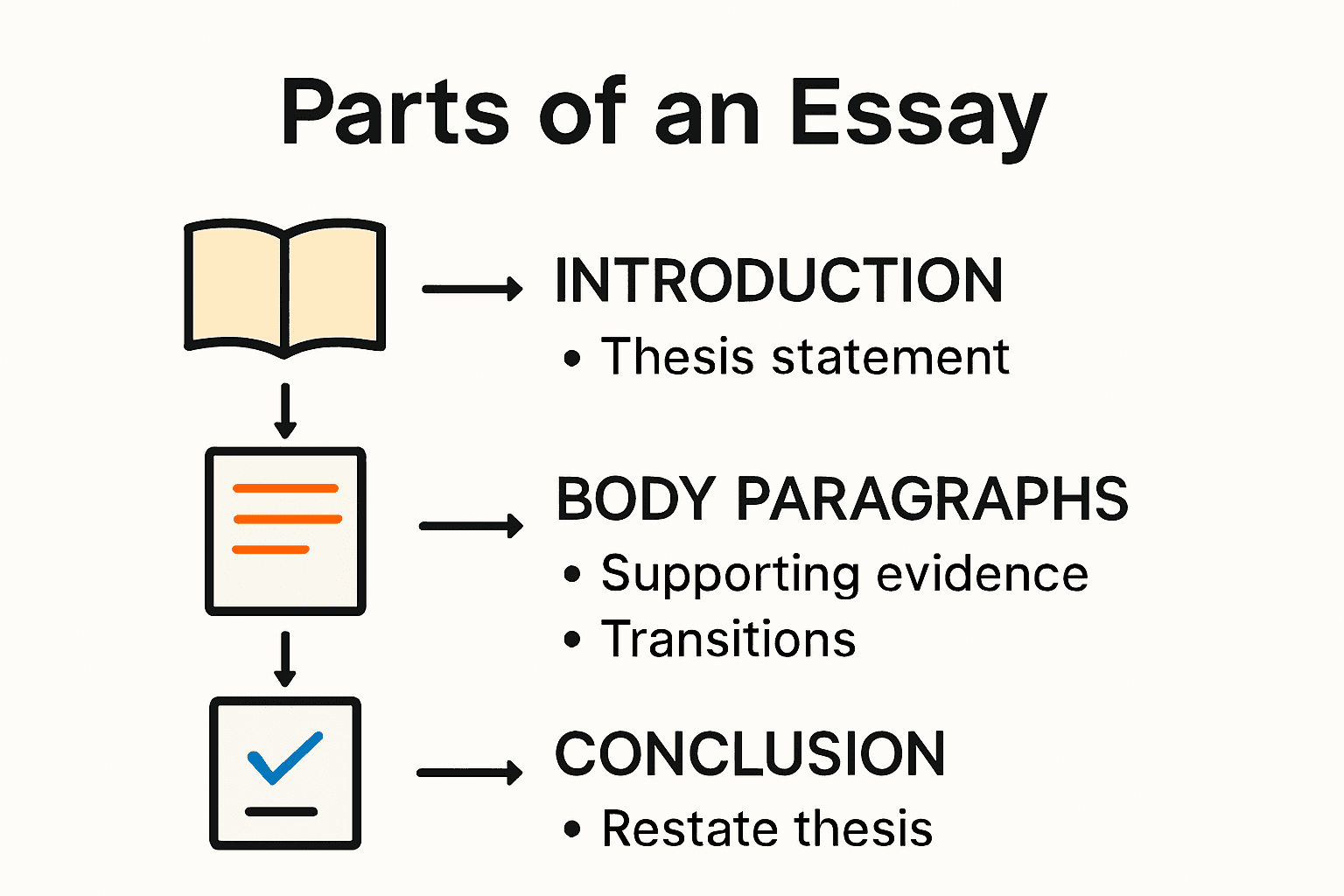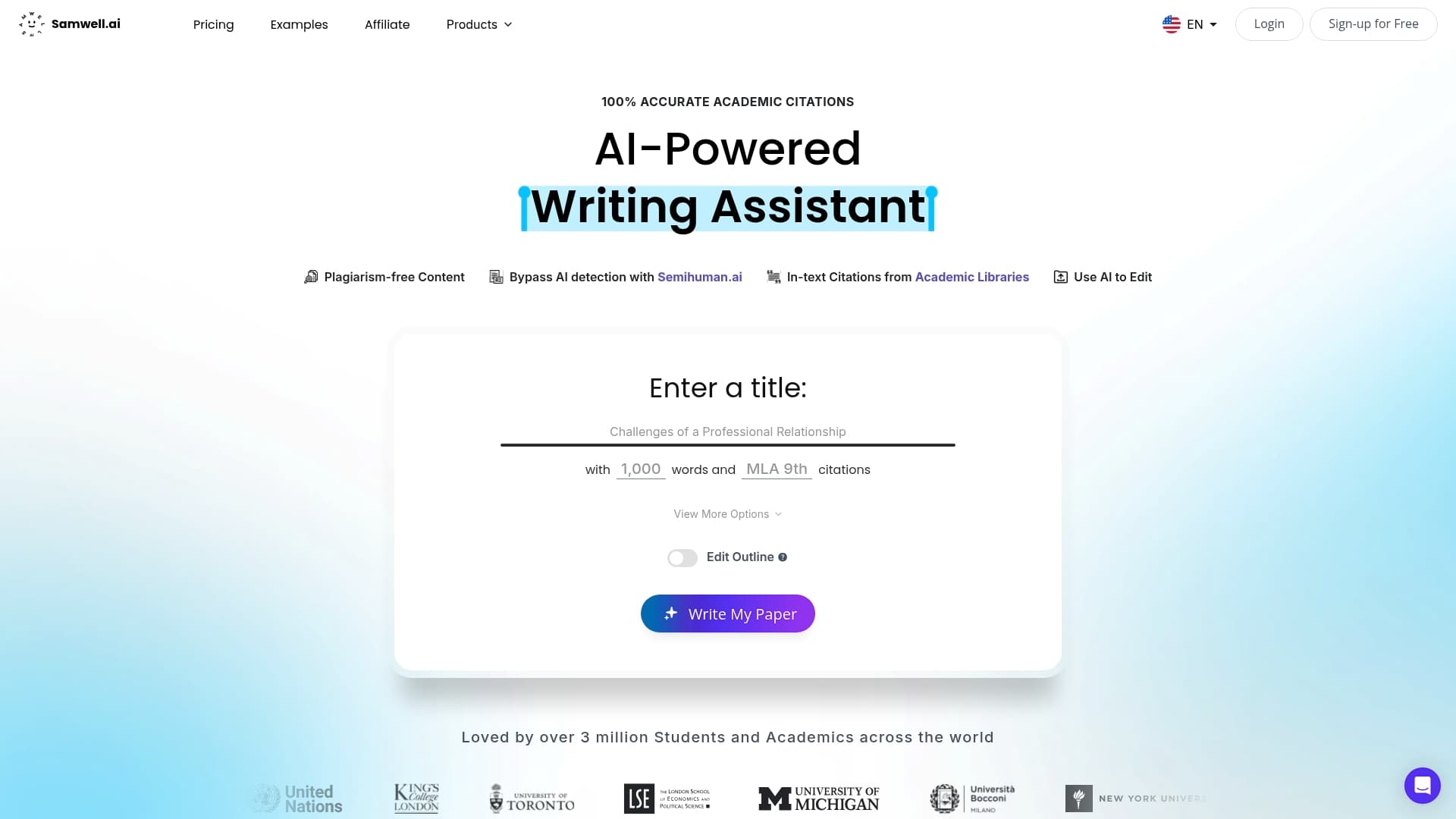Blog
Learning Materials
Essay Proper Format: Easy Guide for Students and Educators
Updated: August 9, 2025

Essay format sounds simple on paper but most students are shocked to learn that nearly 70 percent of academic essays lose points due to basic formatting mistakes like improper margins or inconsistent citations. You might think mastering essay structure is just about following a template. The real surprise is how much it shapes your entire argument and even affects your credibility in the eyes of your professor.
Table of Contents
- Understanding The Essay Proper Format Dockerfile README.md email-templates i18n-config.ts i18nConfig.ts next-sitemap-samwell.config.js next-sitemap-semihuman.config.js next.config.js node_modules package-lock.json package.json process_content.js public scripts src svgr.d.ts translations tsconfig.json Core Components Of Essay Structure Dockerfile README.md email-templates i18n-config.ts i18nConfig.ts next-sitemap-samwell.config.js next-sitemap-semihuman.config.js next.config.js node_modules package-lock.json package.json process_content.js public scripts src svgr.d.ts translations tsconfig.json Paragraph Development And Logical Flow Dockerfile README.md email-templates i18n-config.ts i18nConfig.ts next-sitemap-samwell.config.js next-sitemap-semihuman.config.js next.config.js node_modules package-lock.json package.json process_content.js public scripts src svgr.d.ts translations tsconfig.json Citation And Academic Integrity
- Key Elements Of A Well-Formatted Essay Dockerfile README.md email-templates i18n-config.ts i18nConfig.ts next-sitemap-samwell.config.js next-sitemap-semihuman.config.js next.config.js node_modules package-lock.json package.json process_content.js public scripts src svgr.d.ts translations tsconfig.json Structural Foundations Dockerfile README.md email-templates i18n-config.ts i18nConfig.ts next-sitemap-samwell.config.js next-sitemap-semihuman.config.js next.config.js node_modules package-lock.json package.json process_content.js public scripts src svgr.d.ts translations tsconfig.json Evidence And Analysis Dockerfile README.md email-templates i18n-config.ts i18nConfig.ts next-sitemap-samwell.config.js next-sitemap-semihuman.config.js next.config.js node_modules package-lock.json package.json process_content.js public scripts src svgr.d.ts translations tsconfig.json Academic Presentation And Style
- Step-By-Step Essay Formatting Instructions Dockerfile README.md email-templates i18n-config.ts i18nConfig.ts next-sitemap-samwell.config.js next-sitemap-semihuman.config.js next.config.js node_modules package-lock.json package.json process_content.js public scripts src svgr.d.ts translations tsconfig.json Page Setup And Basic Formatting Dockerfile README.md email-templates i18n-config.ts i18nConfig.ts next-sitemap-samwell.config.js next-sitemap-semihuman.config.js next.config.js node_modules package-lock.json package.json process_content.js public scripts src svgr.d.ts translations tsconfig.json Header And Page Numbering Dockerfile README.md email-templates i18n-config.ts i18nConfig.ts next-sitemap-samwell.config.js next-sitemap-semihuman.config.js next.config.js node_modules package-lock.json package.json process_content.js public scripts src svgr.d.ts translations tsconfig.json Citation And Reference Formatting
- Common Mistakes And Expert Tips Dockerfile README.md email-templates i18n-config.ts i18nConfig.ts next-sitemap-samwell.config.js next-sitemap-semihuman.config.js next.config.js node_modules package-lock.json package.json process_content.js public scripts src svgr.d.ts translations tsconfig.json Structural And Compositional Errors Dockerfile README.md email-templates i18n-config.ts i18nConfig.ts next-sitemap-samwell.config.js next-sitemap-semihuman.config.js next.config.js node_modules package-lock.json package.json process_content.js public scripts src svgr.d.ts translations tsconfig.json Grammatical And Technical Pitfalls Dockerfile README.md email-templates i18n-config.ts i18nConfig.ts next-sitemap-samwell.config.js next-sitemap-semihuman.config.js next.config.js node_modules package-lock.json package.json process_content.js public scripts src svgr.d.ts translations tsconfig.json Plagiarism And Academic Integrity
Quick Summary
| Takeaway | Explanation |
|---|---|
| Understand core essay structure | A strong essay includes an introduction, body paragraphs, and a conclusion that ties all points together. |
| Focus on paragraph development | Each paragraph should maintain unity, coherence, and clearly connect to the main thesis with topic sentences and transitions. |
| Utilize correct citation styles | Use consistent citation formats like APA, MLA, or Chicago to credit sources and maintain academic integrity. |
| Avoid common structural mistakes | Ensure your thesis is specific, paragraphs are consistent, and provide adequate evidence to support claims. |
| Proofread to eliminate errors | Check for grammatical mistakes, incorrect tenses, and citation formatting issues to enhance academic credibility. |
Understanding the Essay Proper Format
Essay proper format serves as the foundational structure that transforms raw ideas into coherent academic communication. Students and educators alike must understand this critical framework to effectively convey complex thoughts and arguments. Mastering essay proper format goes beyond mere aesthetic presentation it represents a systematic approach to organizing intellectual discourse.
Core Components of Essay Structure
The anatomy of a well-formatted essay consists of several essential elements that work together to create a logical and compelling narrative. According to the University of North Carolina at Chapel Hill's Writing Center, these components include a clear thesis statement, well-developed body paragraphs, and a conclusive ending that ties the entire argument together.
A robust essay proper format typically includes:

- Introduction: A compelling opening that presents the central argument and provides context
- Body Paragraphs: Structured sections that develop and support the main thesis
- Conclusion: A synthesizing section that reinforces the essay's primary points
Paragraph Development and Logical Flow
Paragraph construction represents a critical aspect of essay proper format. Dartmouth College's Writing Program emphasizes that each paragraph must maintain unity, coherence, and a clear connection to the overarching thesis. Effective paragraphs typically feature a topic sentence that introduces the main idea, followed by supporting evidence and analysis.
Successful paragraph development requires writers to:
- Establish a clear central idea
- Provide relevant supporting evidence
- Maintain a logical sequence of thoughts
- Create smooth transitions between paragraphs
Citation and Academic Integrity
Proper formatting extends beyond structural considerations and encompasses academic citation practices. The Purdue Online Writing Lab highlights the importance of consistent citation styles like APA, MLA, or Chicago, which not only give credit to original sources but also demonstrate scholarly rigor.
For those seeking more comprehensive guidance, our comprehensive essay format guide offers in-depth strategies for crafting exceptional academic essays. Understanding and implementing these formatting principles transforms writing from a mere task into an art of clear, persuasive communication.
Key Elements of a Well-Formatted Essay
Crafting a well-formatted essay requires strategic planning and precision. Academic writing demands more than just stringing words together it requires a deliberate approach that communicates ideas clearly and persuasively. Understanding the key elements transforms an ordinary piece of writing into a compelling academic document.
Structural Foundations
The structural integrity of an essay determines its effectiveness. According to William & Mary College's Writing Resources, a successful academic essay must exhibit independent thought and engage critically with the subject matter. This means developing a focused thesis that serves as the essay's intellectual backbone.
Key structural components include:
- Clear Thesis Statement: A precise, arguable claim that guides the entire essay
- Logical Argument Progression: Sequential development of ideas that builds toward the central argument
- Coherent Paragraph Design: Each paragraph functioning as a mini-argument supporting the larger thesis
Evidence and Analysis
Utah Valley University's Writing Center emphasizes the critical role of evidence and analysis in essay composition. Each body paragraph must do more than simply present information it must interpret and contextualize that information within the broader academic discussion.
Effective evidence integration involves:
- Selecting relevant and credible sources
- Directly connecting evidence to the thesis
- Providing analytical commentary that explains the significance of the evidence
- Maintaining a critical and objective scholarly tone
Academic Presentation and Style
Beyond content, academic essays require meticulous presentation. Kirkwood Community College's Writing Resources highlights that proper formatting communicates scholarly discipline and intellectual rigor.
Style considerations include:
- Consistent citation format (APA, MLA, Chicago)
- Professional language and tone
- Precise and concise word choice
- Smooth transitions between paragraphs and ideas
For students seeking comprehensive guidance on crafting exceptional academic papers, our detailed essay writing resource offers step-by-step strategies to elevate your writing. Mastering these key elements transforms essay writing from a challenging task into an opportunity for intellectual expression and academic excellence.
Step-by-Step Essay Formatting Instructions
Mastering essay formatting requires a systematic approach that transforms raw writing into a polished academic document. Students and researchers must navigate multiple technical and stylistic requirements to create a professional presentation that meets scholarly standards.
Page Setup and Basic Formatting
The foundation of proper essay formatting begins with fundamental technical specifications. Purdue University's Online Writing Lab recommends precise guidelines for creating a professional document:
- Page Margins: Set to 1 inch on all sides
- Font Selection: Use standard academic fonts like Times New Roman or Arial
- Font Size: 12 point for body text
- Line Spacing: Double spacing throughout the entire document
- Alignment: Left alignment with a ragged right margin
These basic parameters establish a clean, readable template that allows your content to shine without unnecessary visual distractions.
Header and Page Numbering
Professional essay formatting demands consistent header and page numbering practices. Each page should include:
- Student name in the top left corner
- Course information
- Instructor's name
- Submission date
- Consecutive page numbers in the top right corner
For those seeking more nuanced guidance on creating professional academic documents, our comprehensive MLA writing guide provides detailed insights into advanced formatting techniques.
Citation and Reference Formatting
Citation style represents the final critical element of essay formatting. Different academic disciplines require specific citation formats:
- MLA: Preferred in humanities and liberal arts
- APA: Standard in social sciences
- Chicago: Common in history and some humanities disciplines
Each citation style has unique requirements for:
- In-text citations
- Reference page formatting
- Handling direct quotes
- Referencing different source types
To help students clearly see the distinctions between major academic citation styles, the following table summarizes the key citation formats mentioned in the article and their typical use cases:
| Citation Style | Primary Discipline(s) | Common Usage |
|---|---|---|
| MLA | Humanities, Liberal Arts | Literature, Philosophy, Arts |
| APA | Social Sciences | Psychology, Education, Sociology |
| Chicago | History, Some Humanities | History, Anthropology, Publishing |
Careful attention to these details demonstrates academic rigor and intellectual integrity. By following these step-by-step instructions, students can transform their writing from a rough draft into a professionally formatted academic document that meets the highest scholarly standards.
Common Mistakes and Expert Tips
Essay writing presents numerous challenges that can undermine even the most thoughtful academic work. Understanding common pitfalls and learning expert strategies can dramatically improve the quality and effectiveness of academic writing.
Structural and Compositional Errors
Bright Hub Education highlights several critical mistakes students frequently make in essay composition. These errors can significantly diminish the impact of an otherwise strong argument.
Common structural mistakes include:
- Weak Thesis Statements: Vague or overly broad claims that lack specificity
- Inconsistent Paragraph Structure: Paragraphs that drift from the central topic
- Poor Transitions: Abrupt shifts between ideas that disrupt logical flow
- Inadequate Evidence: Making claims without sufficient supporting documentation
To combat these issues, writers should:
- Develop a clear, specific thesis
- Ensure each paragraph connects directly to the main argument
- Create smooth logical transitions
- Provide concrete evidence for all significant claims
Grammatical and Technical Pitfalls
Academic Writing Resources outline technical errors that can undermine academic credibility. Grammatical mistakes and formatting inconsistencies can distract readers from the core content.
Key technical errors to avoid:
- Inconsistent verb tenses
- Run-on sentences and fragments
- Improper punctuation
- Inconsistent citation formatting
- Spelling and grammatical mistakes
Professional proofreading techniques include:
- Reading the essay aloud
- Using grammar checking tools
- Having a peer review the document
- Taking breaks between writing and editing
To reinforce best practices for avoiding structural and technical errors in essays, the table below provides a checklist summarizing common mistakes listed in the section, along with corresponding expert tips for preventing them:
| Common Mistake | Prevention Tip |
|---|---|
| Weak Thesis Statement | Develop a clear, specific, and arguable thesis |
| Inconsistent Paragraph Structure | Connect each paragraph directly to the main argument |
| Poor Transitions | Create smooth logical transitions between ideas |
| Inadequate Evidence | Provide concrete evidence for all significant claims |
| Inconsistent Verb Tenses | Proofread for tense consistency throughout |
| Run-on Sentences & Fragments | Edit carefully; use grammar checking tools |
| Improper Punctuation | Review punctuation usage; read essay aloud |
| Inconsistent Citation Formatting | Follow guidelines for one citation style throughout |
| Spelling & Grammatical Mistakes | Use spelling/grammar checks and peer review |
Plagiarism and Academic Integrity
Perhaps the most serious mistake in academic writing is plagiarism. This goes beyond simple citation errors and represents a fundamental breach of scholarly ethics. Students must:
- Always attribute sources correctly
- Use quotation marks for direct quotes
- Paraphrase with proper citations
- Understand the difference between referencing and copying
For students seeking deeper insights into avoiding academic writing pitfalls, our comprehensive citation guide provides advanced strategies for maintaining academic integrity.
Mastering these expert tips transforms essay writing from a potential minefield of errors into an opportunity for clear, compelling academic communication. By understanding common mistakes and implementing strategic solutions, students can elevate their writing and demonstrate true scholarly excellence.

Frequently Asked Questions
What are the core components of a properly formatted essay?
A well-formatted essay typically includes an introduction, body paragraphs that support the main thesis, and a conclusion that synthesizes the key points.
How can I ensure logical flow in my essay paragraphs?
Maintain unity and coherence by starting each paragraph with a clear topic sentence, providing relevant supporting evidence, and using smooth transitions between ideas.
What are the common citation styles used in academic essays?
The most common citation styles are MLA (for humanities), APA (for social sciences), and Chicago (for history and some humanities disciplines). Each has specific rules for in-text citations and reference formatting.
What are some common formatting mistakes to avoid in academic essays?
Some common mistakes include weak thesis statements, inconsistent paragraph structure, poor transitions between ideas, and insufficient evidence to support claims.
Struggling With Essay Format? Achieve Perfect Structure With AI Guidance
You spent hours shaping your introduction, body paragraphs, and conclusion, but small formatting mistakes or missed citation details can still cost you valuable points. Many students lose confidence after seeing feedback about inconsistent essay structure, unclear thesis statements, or improper use of sources. If you recognize these challenges from your own academic experience, you are not alone. Proper essay formatting, citation style, and paragraph coherence are crucial for academic success, but they can be tough to master on your own.

Elevate your writing with the innovative tools at Samwell.ai, trusted by over 1,000,000 students and professionals. Access advanced features like the Power Editor for seamless formatting, and use our Essay Paper Example guide to review proven structures you can follow. Start today with the platform designed to ensure your work meets academic standards and stands out for its clarity and originality.
Recommended
- Academic Writing Basics: Essential Tips for Students and Educators - Aithor
- Essay Layout Example: A Practical Guide for 2025
Generate essays with Samwell.ai
Whether you’re a publisher, professor, journalist, or student, let us tailor a plan just for you.Most Read Articles

Your Guide to Help Writing a Essay Successfully
Expert tips for help writing a essay - from crafting a thesis to structuring your essay effectively.

How to Write Critical Thinking Essay: Expert Tips
Expert tips for writing a critical thinking essay. Learn how to structure, choose topics, and use evidence effectively.'

How to Write a Good Hook: A Step-by-Step Guide
Master the art of crafting a good hook with our guide. Create compelling openers for a memorable first impression.
